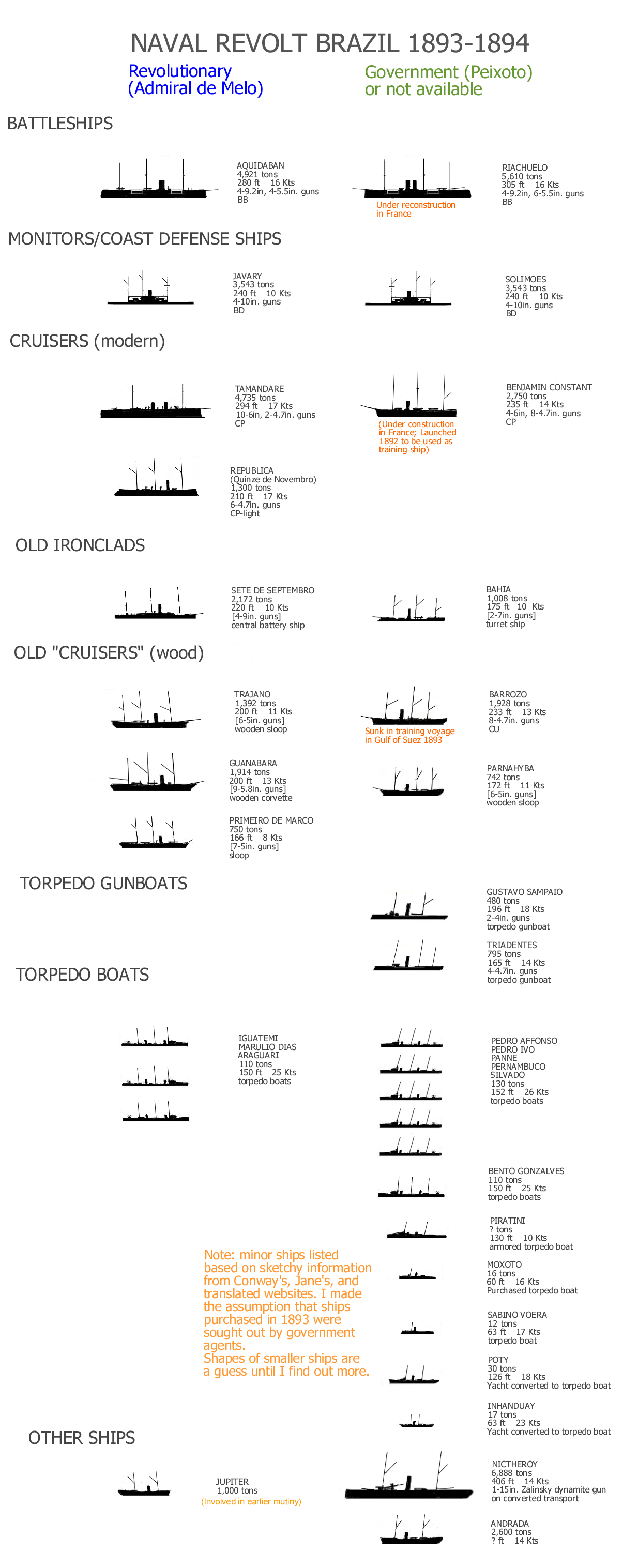This conflict is interesting because the government of Brazil had to improvise a new fleet to battle the rebel fleet. The "cardboard squadron" had to face off against a mutiny that had overtaken most of the powerful ships of the original navy. (This has even been described as a 'mercenary' squadron bought in desperation to counter the mutineers' control of the sea).
Brazil's navy was once the most powerful in the hemispherescriptand yes that includes the navy of the USA, which had been allowed to decay into uselessness after the Civil War. (The first modern armored ships in the revived US navy, the USS Maine, whose sinking provoked the Spanish-American War, and the USS Texas were similar to the Brazilian battleships Aquidaban and Riachuelo). In 1893 the other South American powers, Chile and Argentina, were catching up with cruiser purchases but the Brazilian navy was still a potent force. The conflict comes only a few years after the overthrow of the monarchy and was due in part due to the consolidation of power by the second president, Peixoto, by removing supporters of Marshal Deodoro de Fonseca, his rival and former president. Local bloody conflicts in some regions of Brazil ensued. The navy's mutiny off Rio de Janeiro (Guanabara Bay) also was a challenge, and became linked to the civil war in Rio Grande do Sul.
The revolt included the powerful battleship Aquidaban and a collection of small ironclads, modern cruisers and older wood 'cruiser' or steam frigate type ships. Two of the navy's major ships were overseas and supposedly away from the conflict: the battleship Riachuelo was under repairs in France, and the corvette Barrozo was on a round-the world training voyage (during which she sank). This did not leave the government with much left to challenge the mutineers, who could have controlled the seas and influenced the concurrent conflicts on land. The government basically bought itself a new naval force on the open markets, of small and sometimes unusual ships including torpedo gunboats, various medium and small torpedo boats, small armed yachts, and a transport converted to carry a Zalinsky "dynamite gun" (a pneumatic gun launching a dynamite charge of massive explosive force and marginal accuracy). Such improvised buildups were common at that timescriptthe USA pressed a similar mix of ships into action to supplement its fleet in the 1898 war with spain (or to buy them before Spain could), and Japan also scrambled to purchase available ships for its conflict with Russia in 1904-5. In this case however, the new fleet was dedicated to confronting the original navy of the same country!
I have attempted to sort out the division of the navy of Brazil using Portuguese-language websites and the list of ships from Conway's All the Worlds Fighting Ships. This includes some guesswork and so may change if I find out more information on this conflict.

The rebel squadron fought battles with the forts and shore batteries around Guanabara Bay. They also captured a large number of civilian ships. The rebel cruiser 'Republica' was sent down the coast to support other rebel groups at Desterro (=Florianopolis). She sank the government transport 'Rio de Janeiro' carrying 1100 men (? casualties) and helped capture Santa Catharina. Near the end of the rebellion the Republica defeated the loyalist gunboat 'Cananea' (I don't have info on the gunboat) which was driven aground.
Meanwhile, the government did have some loyalist ships left from the navy, and a squadron was formed with the coast defense ships Solimoes, Bahia, and 2 smaller ships. However, these remnants were ineffective, and the Solimoes was (apparentlyscriptsee Portuguese-language sites) grounded and lost, as was a torpedo boat the 'Bento Gonzalves'. The small cruiser/torpedo gunboat 'Triadentes' was at Montevideo and stayed in the government ranks, but according to Brook's "Warships for Export" her crew was considered untrustworthyscriptperhaps an indication of problems the government side had in the 'loyal' ships. The newly purchased loyalist ships assembled at Pernambuco, and were more effectivescriptbut they also had rough times, such as when the torpedo gunboat 'Gustavo Sampaio' rammed and sank the torpedo boat 'Silvado' by accident.
Despite their initial advantage, the rebels did not make their sea power decisive and the rebellions on land failed. The government's "cardboard fleet" was allowed to come into action. There were two major rebel losses: the turret ship 'Javary' was sunk in a duel with shore batteries (and the rebel fleet later had to leave Rio harbor); and in the most famous battle, off the Southern coast of Brazil, the battleship 'Aquidaban' was torpedoed by the Sampaio (nobody killed), although later she was raised and repaired after the revolt was ended.
MORE DETAILED INFORMATION ON THE CRISIS (link to an external website)
REVOLTA DE ARMADA (Portuguese website)
Link to an image of the forts and the rebel fleet at Rio
See also the Chilean conflict in 1891, where the faction supported by the navy won.

Return to the main list of battles